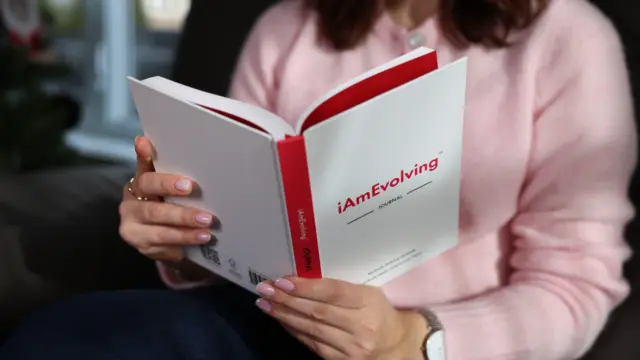Continue shopping
and explore our products below:
Turning Self-Doubt into Self-Belief

We all experience moments when our confidence wavers. Maybe you’ve had an idea you didn’t share, an opportunity you didn’t take, or a dream you quietly set aside because that inner voice whispered, “You’re not ready.” When this happens, it helps to trust the process and allow growth to unfold one step at a time.
That’s self-doubt — quiet but powerful. Yet what most people don’t realize is that self-belief can be learned, trained, and strengthened like any other habit.
In this guide, you’ll discover how to understand your doubt, rewrite your inner dialogue, and use daily practices — including journaling — to build lasting self-trust and inner confidence.
1. Understanding Where Self-Doubt Comes From
Self-doubt isn’t weakness — it’s often a learned pattern.
It comes from years of messages, both subtle and direct, that made you question your worth. Maybe a teacher once told you not to aim too high. Maybe you compared yourself to someone else’s success online. Over time, these moments leave mental traces.
Our brains remember fear more easily than courage.
When you recall a mistake, your mind tries to protect you from repeating it by creating hesitation. That hesitation feels like truth — but it’s really a defense mechanism, not a reflection of your potential.
The good news? You can retrain it.
Self-belief grows each time you notice the doubt, question it, and take action anyway.
Confidence is not the absence of doubt — it’s the decision to move forward despite it.
2. Rewriting Your Inner Dialogue
The language you use in your thoughts shapes how you see yourself. For more support in this process, explore how journaling helps with anxiety and depression and builds calm, self-awareness, and inner strength.
When you think “I can’t,” “I always fail,” or “I’m not enough,” your brain records those statements as fact. But just as negative repetition weakens your confidence, positive repetition can strengthen it.
Next time you hear a self-critical thought, pause.
Ask yourself, “Is this fact or fear?”
Then replace it with something grounded but empowering.
- Instead of “I’m not ready,” say, “I’m learning as I go.”
- Instead of “I can’t do this,” say, “I can try, and that’s progress.”
- Instead of “I failed,” say, “I learned what doesn’t work — and I’ll adjust.”
This isn’t about toxic positivity — it’s about training your mind to look for possibility instead of limitation.
Daily journaling tip:
Each morning, write one encouraging sentence that begins with “I am.” For example:
I am capable of growth, even when it feels uncertain.
Over time, your mind will begin to trust this voice more than the one rooted in fear.
3. Take Imperfection Off the Pedestal
Many people wait to feel confident before acting. The problem?
Confidence comes after action, not before.
Perfectionism fuels self-doubt because it tells you that anything less than flawless is failure. But perfection isn’t real — progress is.
When you start valuing effort over outcome, your sense of self-belief strengthens naturally.
Try journaling about:
- A time you did something imperfectly but were proud anyway.
- What fear keeps you from starting right now.
- One small, imperfect step you can take today.
You’ll realize confidence doesn’t appear magically — it grows in the moments you show up, even when you’re unsure.
4. Build Self-Belief Through Consistency
Every time you keep a promise to yourself, you collect evidence that you’re trustworthy. Explore 10 journaling habits that will transform your life to stay grounded and consistent in your self-reflection practice.
Self-belief is built on this kind of evidence — small, consistent acts that prove you can rely on yourself.
Here’s a simple structure from the iAmEvolving Journal you can use daily:
Morning
- Write one clear, achievable goal.
- Add one sentence about why it matters.
Evening
- Reflect: Did I keep my promise to myself today?
- End with one sentence of gratitude for your effort, not the outcome.
Even on days you fall short, the act of reflection builds self-awareness and resilience — the two pillars of confidence.
Belief is not built by doing everything right, but by refusing to give up on yourself.
5. The Role of Journaling in Transforming Self-Doubt
Journaling is one of the most effective tools for transforming self-doubt because it gives your thoughts a voice.
When left unexpressed, doubts swirl endlessly in your mind. But when written down, they lose power — you can see them clearly, analyze them, and replace them with truth.
Here are a few powerful prompts to use:
- What belief about myself do I want to let go of?
- What’s one thing I’ve achieved that I once thought I couldn’t?
- When did I prove my resilience recently?
- What does self-belief look like in my daily life?
- How can I show myself compassion when things get hard?
If you use the iAmEvolving Journal, write your responses in the Inner Harmony section. Over time, you’ll see patterns shift — from judgment to understanding, and from fear to trust.
6. Separate Facts from Feelings
One of the biggest mistakes we make is treating feelings as facts.
Feeling unqualified doesn’t mean you are unqualified. Feeling scared doesn’t mean you’re not capable.
Your emotions are valid, but they’re temporary signals — not truths.
Here’s a mindset exercise you can try:
- Write down a recurring doubt — for example, “I’m not good at staying consistent.”
- List actual evidence for and against that belief.
- You’ll often find more proof on the positive side than you expected.
This process retrains your brain to recognize the difference between emotion and reality — an essential skill for self-confidence.
7. Surround Yourself with Growth-Minded People
Confidence is contagious. Surround yourself with those who cultivate positive daily habits that strengthen your mindset and remind you that growth is a daily practice.
When you spend time with people who challenge themselves, speak kindly about their efforts, and pursue growth, you naturally begin to reflect those patterns.
If your current circle often focuses on limitation or criticism, balance it with sources that lift you up — podcasts, books, communities, or mentors that reinforce a mindset of possibility.
Even following one positive creator online who shares authentic progress (not perfection) can shift your perception of what’s possible for you.
8. Redefine Failure as Feedback
Self-doubt thrives on fear of failure.
But what if failure wasn’t something to avoid — but something to use?
Every misstep reveals data: what didn’t work, what to adjust, and what to try differently.
That’s how growth happens — not in the perfect outcome, but in the willingness to keep learning.
Next time you face a setback, journal about it like a scientist:
- What happened?
- What did I learn?
- What will I do next time?
You’ll begin to view challenges as information instead of proof of inadequacy.
9. Anchor Yourself in Your Values
When you lose sight of what truly matters, it’s easy to doubt yourself.
Your values are like a compass — they remind you who you are when uncertainty clouds your judgment.
Take a moment to define your top three values.
For example: integrity, creativity, kindness.
Ask yourself: How can I express these values today, in one small way?
When your actions align with your values, you stop seeking external validation. You trust yourself because your choices feel right — not because others approve.
10. Turn Self-Belief into a Way of Living
Eventually, all of these practices — journaling, reflection, taking action, rewriting your thoughts — combine into a quiet but steady confidence.
You stop needing to prove your worth and start embodying it.
That’s what true self-belief looks like. It’s not loud or performative; it’s grounded. You don’t have to convince anyone — not even yourself — because your actions already reflect it.
Every time you write, reflect, and choose growth, you strengthen your belief that you are evolving — and that belief changes everything.
Affirmation: I am becoming someone who trusts their own path.
Building self-belief is a gradual process — it begins with awareness and strengthens through daily choices. Every time you notice your doubt and choose to act with intention, you’re already rewriting your story. Keep nurturing that awareness and inner confidence as part of your ongoing journey in Self-Awareness & Identity.


